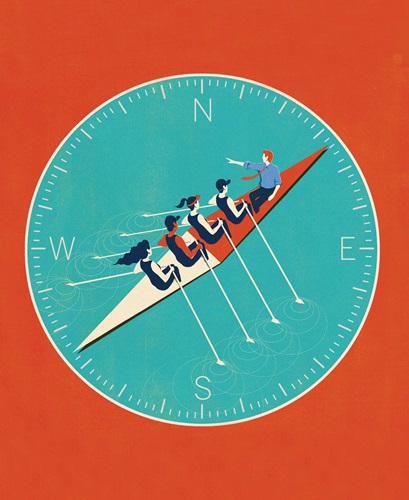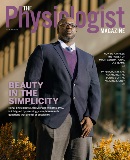Leaders’ Edge
Science education often doesn’t teach you how to be a manager. Learn how to motivate and lead from these exemplars.
By Scott Sleek

Early in his career, Jeremy Boss, PhD, had no training manual to help him navigate the administrative duties he was taking on. So he wrote one himself.
In 2003, the Emory University immunologist produced “Academic Scientists at Work: Navigating the Biomedical Research Career,” with his then-colleague Susan H. Eckert, PhD, in response to the lack of direction he felt he needed to handle many of his management challenges—coaching underperforming students, running meetings, hiring and firing staff.
“We watched how others approached these problems, and if you went to enough people, you could come up with a set of answers to how you solve them,” says Boss, who now chairs the Department of Microbiology and Immunology at the Emory University School of Medicine in Atlanta. “But it was very clear there was no source of information.”
Many new lab directors find themselves unprepared for the logistical, personnel and budgetary obligations that come with the job. They must balance enforcing policies and standards, overseeing data integrity, securing funding, supervising lab technicians and mentoring their students and postdoctoral fellows. But traditional scientific training affords them little preparation for leading and motivating other researchers, says Alison Antes, PhD, an organizational psychologist who studies biomedical research ethics at Washington University in St. Louis.
“You’re budgeting, you’re hiring, you’re recruiting people and dealing with performance problems, you’re mentoring and giving career advice. You’re basically required to be the executive team, the top management team, the supervisory team, admin, HR. And you’re learning all this on the fly.”
Alison Antes, PhD
“You’re trained to be in a lab collecting data, then you transition, and now you’re managing other people who do science,” she says. “You’re budgeting, you’re hiring, you’re recruiting people and dealing with performance problems, you’re mentoring and giving career advice. You’re basically required to be the executive team, the top management team, the supervisory team, admin, HR. And you’re learning all this on the fly.”
Despite the dearth of guidance on leadership and management in science, many researchers have honed some model skills to help their labs thrive, Antes’ research has shown. In 2019, she and her colleagues asked nearly 1,500 deans, department chairs and research administrators to nominate the scientists at their institutions who epitomize professionalism and integrity. The nominations helped Antes’ team build a cohort of “research exemplars”—highly accomplished investigators in diverse scientific fields.
They interviewed these exemplars, asking them about the practices they use to foster rigorous research among the people working in their labs. As reported in PLOS One in April 2019, these leaders mentioned vital practices such as thoroughly cross-checking data and findings, storing data appropriately and enforcing standard operating procedures. But the approaches they cited most consistently involved so-called “people skills”—training, mentoring and uniting their research teams. They endeavor to be approachable and to create a non-threatening work environment. They want their team members to feel comfortable and safe in asking questions, raising concerns and reporting mistakes.
This leadership style invokes the concept of psychological safety, an idea championed by Amy Edmonson, PhD, the Novartis Professor of Leadership and Management at Harvard Business School in Boston. Edmonson’s research shows that work teams perform at their best when they fear no punishment or humiliation for voicing their ideas, asking questions and owning their mistakes.
“Research involves obstacles and challenges, especially when you’re trying to collect data from humans,” Antes says. “And if you have a psychologically safe environment, then people feel comfortable telling you that there’s a problem to solve, as opposed to not bringing it up and being reluctant to have those kinds of conversations.”
Minson scheduled weekly meetings over Zoom so that lab staff could report on their accomplishments, ongoing projects and long-term objectives. “We were just losing track of what people were doing, where they were going,” he explains. “So the idea was just to have something to help them stay focused and accountable.”
The laboratory of Christopher Minson, PhD, director of the Human Cardiovascular Control Laboratory at the University of Oregon, exemplifies the model of a safe and collaborative work environment. Minson not only strives to be supportive and available, but he aims to recruit trainees and staff who share those traits. He is always impressed with applicants who have participated in team sports, played in bands or worked in some other group that requires cooperation and collaboration.
“What I say to my students is that no one is ever successful in a vacuum,” he says. “I think it’s really true. If you’re left to your own devices, you may have a little bit of success, but you really need good people, a good team, good communication.”
Exemplars also communicate expectations and standards clearly. And they confront performance issues directly and supportively. “People want honesty,” Boss says. “They don’t want to be yelled at. They don’t want to be criticized. But they also want to know how they can fix their shortcomings.”
What are other effective leadership steps that physiologists can use to create psychological safety and robust science? Here are a few:
Hold regular meetings
Meetings create the opportunity for lab staff to share and critique data they’ve all collected. A participant in Antes’ study called the lab meeting the most important event of the week because team members show their raw data for others to critique. Meetings also ensure that everyone clearly understands their responsibilities and next steps.
Meetings have become especially critical in the face of the COVID-19 pandemic, Minson says. Much of the activity in his lab froze in spring 2020 when campuses across the country closed. Staff and trainees worked remotely, making it difficult to track work productivity and progress. Team members could no longer have the spontaneous, collaborative conversations that spark new ideas and help drive the research forward.
In response to those changes, Minson scheduled weekly meetings over Zoom so that lab staff could report on their accomplishments, ongoing projects and long-term objectives. “We were just losing track of what people were doing, where they were going,” he explains. “So the idea was just to have something to help them stay focused and accountable.”
Encourage shared ownership and decision-making
Many principal investigators (PIs) interviewed in Antes’ study said they have all their team members collaborate on study plans and establish a role for each individual. Having multiple individuals working on a project ensures the team analyzes data thoroughly and spots any gaps. Some PIs include their teams in designing compliance protocols and submitting study plans to institutional review boards.
“Everybody has the opportunity to interview with applicants, provide feedback. And everybody’s got to be involved in writing grant proposals. The goal of the lab is to do science, and we need money to do that. I ask everybody to participate both for help and as a training experience.”
Jeremy Boss, PhD
Boss, who studies the regulation of gene expression in the immune system, says involving his students and postdoctoral fellows in all decisions and operations—from hiring to garnering funding—broadens their training. “Everybody has the opportunity to interview with applicants, provide feedback,” he says. “I actually rely on them to do that. And everybody’s got to be involved in writing grant proposals. The goal of the lab is to do science, and we need money to do that. I ask everybody to participate both for help and as a training experience.”
Supervise and guide appropriately
Many PIs emphasize frequent, if not daily, interactions with team members to help identify and solve problems in data collection. Some mentioned having “open door” policies with their students and fellows. PIs with large teams or labs oversee managers or coordinators to provide some of the supervisory support, but still interact regularly with all members of the team.
Minson has created a co-mentoring approach with John Halliwill, PhD, FAPS, head of the University of Oregon’s Department of Human Physiology, which Minson says broadens the guidance his students receive. In essence, he says, the students get two mentors with different but buttressing personalities.
“I’m very much an idea-generating, jam-session kind of mentor, whereas Dr. Halliwill is more detail-oriented,” Minson explains. “He likes spreadsheets and likes his schedule blocked off to meet with people. I’m like, ‘Come to my office and talk.’ Certain people like my form, and certain people like his form. What’s worked is that students can work with both of us.”
Boss mphasizes the importance of listening to individual team members to understand any struggles they’re having and help them build solutions and succeed. “When you take a student in your lab, you’re making a commitment for many years to work with that student, so it’s important to listen to what they say and, if they are having trouble, help them through it.”
Boss says he strives to understand the different motivations that each team member carries, so he can tailor his interactions with them in a way that draws out their best work.
“I always thought, blindly, that all you needed was good data and you’re completely motivated,” he says. “That was my motivation, but it’s not everybody’s motivation. Some need to be appreciated that they had the data. They need to be recognized that they had the data. They needed to be brought into the fold more, to have more of a say.”
Embracing humility and generosity
Many early-career investigators recognize the importance of these leadership concepts but struggle to put the ideas into practice, Antes says. Now, she is pioneering a program to prepare scientists for the management side of their work. With a $2 million grant from the National Institute of General Medical Sciences, the program will train early-career investigators in leadership and administration. Senior and mid-career scientists will contribute to the curriculum, which will be based on the findings Antes collected from the research exemplars.
“One of the main projects I want them to do,” she says, “is to create a lab manual they can leverage to think about their expectations, their philosophy about the lab environment, their basic data management requirements. They can use that as a living document to share it with people working with them.”
Boss believes the ultimate form of leadership involves humility and generosity. “You have to love when someone else is successful—actually more successful than you,” he says. “You have to enjoy allowing people to fully develop.”
This article was originally published in the November 2021 issue of The Physiologist Magazine.
The Physiologist Magazine
Read the Latest Issue
Don’t miss out on the latest topics in science and research.
View the Issue Archive
Catch up on all the issues of The Physiologist Magazine.
Contact Us
For questions, comments or to share your story ideas, email us or call 301.634.7314.
Introducing New APS Leadership Development Resource: Career Gateway
In recent months, the American Physiological Society has asked you, our members, to share your most pressing professional needs so that the Society can help you achieve your goals. You repeatedly told us that traditional scientific training often provides little, if any, emphasis on the foundational skills needed to support the most effective collaboration with colleagues. You also said you wanted resources focused on the development of strong, empathetic leaders and planning intentional, fulfilling careers.
The result: The APS Career Gateway, which launches in November 2021. This new member benefit is designed with you in mind. The Gateway provides leadership, management and career advancement content and courses customized specifically for researchers, educators and trainees. We’ve streamlined access to critical leadership and career advancement resources in a curated, easily accessible structure.
Whether your current priority is to enhance your leadership skills, design a career plan or learn how to best showcase your science, Career Gateway’s got you covered. Visit www.physiology.org/CareerGateway to begin your leadership and career advancement journey.


